Caregivers are often an integral part of the care team and are involved in everything from medication choice to adherence.
Caregivers are significant players in the healthcare ecosystem and, for many individuals, a necessary part of managing an illness or chronic condition. Caregivers provide an estimated $500 billion worth of free care annually — three times Medicaid’s professional long-term care spending, according to a Wall Street Journal article.
But there is a growing gap between the number of caregivers and those who will be needed to address the needs of the aging baby boomer generation. According to an AARP Public Policy 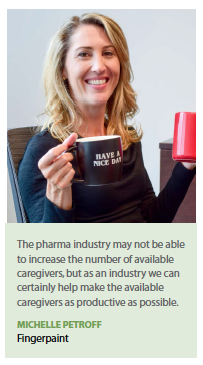 Institute study, in 2010 the caregiver support ratio was more than seven potential caregivers for every person in the high-risk years of 80 plus. But, by 2030 the ratio is expected to decline to four to one. And by 2050, this number drops to less than three to one, which is when the youngest baby boomers will land in the high-risk years.
Institute study, in 2010 the caregiver support ratio was more than seven potential caregivers for every person in the high-risk years of 80 plus. But, by 2030 the ratio is expected to decline to four to one. And by 2050, this number drops to less than three to one, which is when the youngest baby boomers will land in the high-risk years.
Addressing the caregiver gap is an opportunity for the industry, says Michelle Petroff, account service, Fingerpaint. “The pharma industry may not be able to increase the number of available caregivers, but we as an industry can certainly help make the available caregivers as productive as possible," she says. “Caregivers are doing the job of healthcare professionals, which means that in addition to helping their loved ones they are providing cost savings to the health system. Caregivers provide incredibly valuable services, and as the number of caregivers decreases and the demand increases, their value grows exponentially. They have a strong voice and strong buying power, and pharma could see a great return by investing in this ‘workforce.’ "
Ms. Petroff says pharma can help make the workforce of caregivers as competent and productive as possible. “Caregivers often have skill gaps when it comes to their caregiving jobs — they are doing the work of medical professionals but don’t have the formal training. Pharma can be by their side, educating and mentoring them as they navigate diagnoses, treatment decisions, and adherence challenges; advocate for care; and challenge the payer landscape. Investing in these tireless laborers can improve not only their performance, but their job satisfaction — preventing burnout and keeping them in the workforce of caregivers. Their enhanced productivity will help them feel more reward and less burden, and will ultimately help their loved ones get the treatment they need."
The Role of the Caregiver
There are 43.5 million unpaid caregivers, according to a 2015 survey conducted by the National 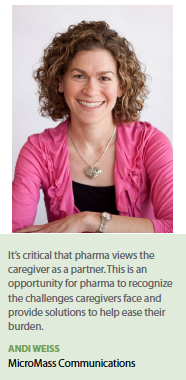 Alliance for Caregiving and AARP. And caregivers’ voices are carrying more weight than ever in terms of influence, and they are increasingly being counted as an integral part of the care team involved in everything from medication choice to adherence.
Alliance for Caregiving and AARP. And caregivers’ voices are carrying more weight than ever in terms of influence, and they are increasingly being counted as an integral part of the care team involved in everything from medication choice to adherence.
“Many times the patient is unable to focus on the necessary parts of an appointment due to symptoms of the condition," says Ken Taylor, patient leader, WEGO Health. “A caregiver can have a clear mind and remember not only what is being said but also direct questions to the doctor."
Mr. Taylor says the patient can be more confident the doctor understands the larger picture than what the patient can provide during difficult times. “I believe a caregiver adds credibility to a patient’s story and what he or she is going through. When a doctor can hear a patient’s story or ask questions to someone who is always around the patient, the physician has another perspective for making important decisions — turning information from subjective to objective."
Mr. Taylor says knowledgeable caregivers offer support and confidence that empowers the patient to become their own best advocate leading to better decisions with their own treatment options. “A caregiver’s expertise about a condition or the healthcare system is very powerful," he adds. “When a patient’s caregiver speaks from a position of knowledge, it breaks communication barriers and lends credibility to a patient who sometimes can’t find his or her own voice."
“The benefits of extended social support can be substantial, as caregivers express and share their experiences, concerns, advice, and other aspects of their personal stories," says Kate Perry, Psych.D., director of behavioral science, Atlantis Healthcare. “With the proper framework, social support can reduce stress and increase confidence for caregivers. Irrespective of the type of platform, the management of the community is a key consideration. Effective community management includes both the activation and prompting of relevant discussions among members, and the responsibility for moderating site content."
Caregivers are instrumental in helping patients understand and move forward with their treatment plan, says Andi Weiss, lead behaviorist, partnerships and advocacy, MicroMass 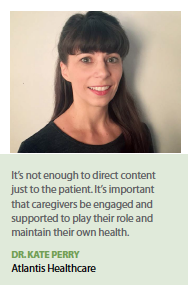 Communications. “Besides managing symptoms, caregivers help with addressing the day-to-day physical and emotional challenges related to clinical and psychosocial needs of patients."
Communications. “Besides managing symptoms, caregivers help with addressing the day-to-day physical and emotional challenges related to clinical and psychosocial needs of patients."
Being a caregiver typically requires becoming a subject matter expert in a specific medical field, whether it is diabetes, cancer, or Alzheimer’s disease. This is especially true in rare disease where it’s often much more difficult to find relevant information. Caregiving also often demands the development of new skills such as blood testing, giving injections, and medication management.
Brad Margus, co-founder and CEO of Cerevance who has two sons with the rare disease ataxia telangiectasia (AT)/Louis-Bar syndrome, says parents of children with rare diseases quickly become disease experts.
“When my kids were diagnosed, most physicians had never seen a kid with this disease and if they did, it was probably the only case he or she would see in their career," he says. “Doctors didn’t know what was typical for the disease or what was unusual for the disease. They would just go to the same websites we did and read a laundry list of all the possible terrible things that can go wrong, but they didn’t really know."
Ataxia telangiectasia is a rare, neurodegenerative disease that affects the nervous system, immune system, and other body systems. This disorder is characterized by progressive difficulty with coordinating movements beginning in early childhood, usually before age 5.
“For so many rare diseases, the big battle is every time caregivers go to a new hospital, they have to educate everybody about the disease," Mr. Margus says.
With his sons’ diagnosis, Mr. Margus left the food industry and began his career as a life-sciences executive, working diligently to align himself with scientists and industry strategists. He helped to create a multidisciplinary clinical center at Johns Hopkins that has now seen hundreds of kids with AT and over the years has developed a natural history and understanding of the disease.
Through this work, Mr. Margus was able to work with a team that identified the gene responsible for causing this disease to proliferate.
Supporting Caregivers
Caregivers face burdens and stressors that are practical, physical, emotional, and psychosocial. Industry leaders say support for caregivers must be multifaceted and address all aspects of caregiving, including self-care.
Carers face huge mental health challenges. Almost 50% of caregivers report depression or 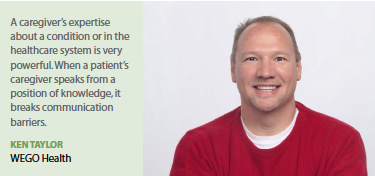 feelings of anxiety and stress, and almost half do not take the time to make medical appointments for themselves, according to a 2017 Embracing Carers International survey by EMD Serono.
feelings of anxiety and stress, and almost half do not take the time to make medical appointments for themselves, according to a 2017 Embracing Carers International survey by EMD Serono.
The importance of informal carers has been highlighted recently in an international campaign — Embracing Carers — initiated by Merck (EMD Serono in the United States) and advised by eight leading caregiver organizations, including the Caregiver Action Network, Carers Worldwide, Eurocarers, and the International Alliance of Carer Organizations (IACO).
A key element of the campaign is to highlight the emotional, financial, and health implications of being an unpaid caregiver. A survey conducted across seven countries — Australia, France, Germany, Italy, Spain, United Kingdom, United States — reported that 42% of carers say they put the health of the person they are caring for above their own, while more than half reported their physical health had suffered.
There’s a long way to go in terms of embracing the caregiver, says Andrea Heslin Smiley, president and CEO, VMS BioMarketing. “Manufacturers have come quite a way. They used to be just focused on professionals, provider, and payers. Now everyone realizes patient-centricity is recognizing that it’s about the influences around that patient. The ecosystem around the patient is important, and the No. 1 component of that ecosystem is the care system that a patient has."
Care partners are the boots-on-the-ground when there isn’t a doctor or nurse in sight. Caregivers have unique experiences and expertise that need to be included in conversations about ideation, design, development, and launch of solutions that will support them while they provide essential care, says Grace Cordovano, Ph.D., a board-certified patient advocate and founder of Enlightening Results, and care partner to disabled adults. “Care partners also have unmet needs that vary greatly from the patient," she adds. “The pharma, digital technology, and the healthcare ecosystems need to acknowledge and adapt to these unmet needs. It is a solid business strategy to partner not only with patients, but with care partners as an industry."
Dr. Cordovano says more can be done to address the basic barriers that care partners regularly face. “As a care partner in the sandwich generation, I want and need access to digital tools that will help me seamlessly coordinate care. It’s not enough for a medication to be prescribed by a doctor. Wearables that monitor basic vitals where actionable insights are easily shared with me are of essence."
She says because many patients with a chronic illness, cancer, or who have multiple co-morbidities take upward of 10 to 15 medications daily, care partners need more than alerts and pill dispensers to help. “We need a digital tool to perform a careful medication analysis and flag things that may need to be deprescribed or discontinued," Dr. Cordovano says. “We need ways to help patients create an optimized, personalized schedule for their medications. We need a tool that can dynamically optimize a daily prescription schedule. I want a digital tool that will help the patient record their side effects and patient-reported outcomes. I want this tool to notify me, the care partner, with actionable insights so we can make an informed decision about our loved one’s care."
Ms. Smiley points out that patients receive a lot of empathy and support from a number of different people, but it’s harder to recognize all the burdens that caregivers have. “The same way that biopharma has put a focus on having a deeper understanding of the patient, there needs to be a greater understanding of caregivers," she says. “We have the opportunity to delve deeply into what those specific needs are by different disease types and how we address those gaps."
Cindy Padgett, VP of commercial operations at PharmaCord, says in her experience care partner members are often ignored, yet they have some of the most difficult jobs, and depending upon the therapeutic area can be the most influential. “To date, companies primarily address care-partner support with education that is often only provided via literature either online and or print. Within the oncology space and products for pediatric patients, we see the additional use of telephonic emotional support for care partners."
She suggests companies embrace more creative solutions, including support through face-to-face forums led by care partner ambassadors, which could vary from monthly meetings to annual 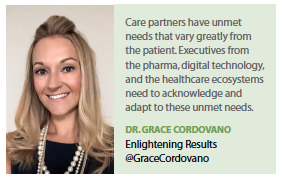 weekend forums that include healthcare professional teams. “These events may include a variety of topics spanning clinical education, medication management, emotional support and offer care partners an opportunity to bond with like care partners," Ms. Padgett says.
weekend forums that include healthcare professional teams. “These events may include a variety of topics spanning clinical education, medication management, emotional support and offer care partners an opportunity to bond with like care partners," Ms. Padgett says.
Another area where the pharma industry can play a pivotal role is in creating platforms where caregivers can connect to a community. This can be done through online platforms, whether using existing social media or constructed in a more personalized manner with a focus on a specific condition.
Ms. Weiss says it’s critical that pharma views the caregiver as a partner. “This is an opportunity for pharma to recognize the challenges caregivers face and provide solutions to help ease their burden," she says. “Caregivers are valuable and trusted partners. Like the patients they care for, their challenges need to be addressed. To drive patient engagement, brands need to involve the patient and the caregiver. The best solution is for marketers to create evidence-based skill-building programs that go beyond education. These programs help caregivers build skills to care for themselves and their loved ones, learn to cope, communicate effectively, and solve problems that commonly surface with the condition or treatment of their loved ones."
Providing Education to Caregivers
Dr. Perry says the pharma industry can play a significant role in navigating the very complex communications dynamic between patient, caregiver, and healthcare professional. “It can be easy for the HCP to focus on either the patient, at the expense of the caregiver, or on the caregiver at the expense of the patient," she says. “It takes time and skill to develop an open, 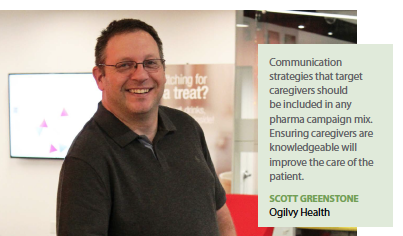 trusting relationship, and that effort is amplified when three interconnected players are involved. Once in place, shared decision-making means less stress on any one member of the trio."
trusting relationship, and that effort is amplified when three interconnected players are involved. Once in place, shared decision-making means less stress on any one member of the trio."
Dr. Perry says pharma companies acknowledge the importance of caregivers in supporting optimal patient self-management, especially with treatment adherence. Accordingly, they are looking to understand and support the needs of the caregivers themselves while they navigate caring for a child, partner, or parent.
“Efforts and outreach grounded in ongoing education are critical to helping caregivers carry out their role with confidence and support," she says. “It’s not enough to direct content just to the patient. It’s important that caregivers be engaged and supported to play their role and maintain their own health."
She says education is not a one-and-done outreach; it’s part of the continuum of care.
“Even caregivers who consider themselves ‘experts’ report seeking ongoing education and support across the duration of their journey," Dr. Perry says. “Ongoing education also enables the caregiver to adjust techniques and tactics as the care recipient moves through a disease process, or transitions across life stages, such as adolescent to adult, or treatment modalities, such as pills to injections."
Scott Greenstone, director, digital strategy — EHR, Ogilvy Health, says caregivers may provide help to patients with direct medication administration, as well as assistance with activities of daily living.
“Therefore, it’s extremely important that caregivers are just as educated, if not more, than the loved ones for whom they care," he says. “Pharma needs to focus on educating caregivers about administration of treatment, side effects, and even warning signs."
Mr. Greenstone says communication strategies that target caregivers should be included in any 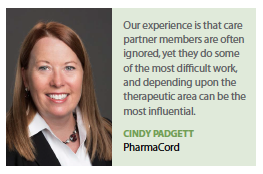 pharma campaign mix. “Ensuring caregivers are knowledgeable will improve the care of the patient and may help reduce much of the burden caregivers feel."
pharma campaign mix. “Ensuring caregivers are knowledgeable will improve the care of the patient and may help reduce much of the burden caregivers feel."
Successful tools include those focused on skills development, whether practical activities around self-management, or emotional support to ensure caregivers don’t neglect their own health while being able to continue to give care.
“Whether these tools are shared via Website modules, workbooks, or telephone calls, it’s critical that the messaging be personalized to where the caregiver is in his or her journey," Dr. Perry says. “Someone who is starting in a new role as a caregiver will need a different type and level of support than someone who has been in that role for many years. Likewise, a caregiver of an adolescent who is transitioning into an adult will face different challenges than a caregiver of an elderly person."(PV)
~~~~~~~~~~~~~~~~~~~~~~~~~
Lessons from Caregivers
To truly understand caregivers and what lies beneath the surface in their experiences and perception, Syneos Health conducted an online survey in August-September 2018 with caregivers in the United States. Through this research, Syneos offers five lessons from caregivers that, if followed, could have profound impact on the industry’s ability to reach caregivers and patients with relevant, resonant messaging.
Lesson #1: Relevance is a Function of Mindset
Messages without sufficient context are left open to interpretation and may be interpreted quite differently even by those in similar circumstances. Sources of motivation and persistence are incredibly personal but not all that unique. You need different messaging to appeal to achievers versus defenders.
Lesson #2: Without Context and Empathy, the Signal Gets Lost
If we want to encourage interaction around a specific dimension of stress, aspect of a condition, or element of adherence, you need to be very explicit or run the risk of our signal being misinterpreted.
Lesson #3: Caregivers are More than Micro-influencers
You can never assume what the impact of any image/message will be on your audience. There may be many different interpretations of what you intended to convey. As such, it’s important to test messaging versions (both visual and verbal) continually.
Lesson #4: Micro-influencers Are Powerful Message Amplifiers
Messaging strategies must balance evergreen aspects of the patient and caregiver journeys with communications around timely moments that matter. Social networks and communities provide a rich ground for insights mining and learning more about the caregiver mindset and the caregiver-patient dynamics.
Lesson #5: Degree of Influence Should Determine Engagement Strategies
Target and message high-influence caregivers directly, engaging them as the primary decision-maker. They are interested in information that can support the decisions they are charged with making.
~~~~~~~~~~~~~~~~~~~~~~~~~
Today’s Caregivers
The profile of the family caregiver in America is changing as the population ages, according to a new research study from the National Alliance for Caregiving and AARP. Caregivers, on the whole, are becoming as diverse as the American population.
82% care for one person who is likely either living with the caregiver or living within 20 minutes of the caregiver.
60% of caregivers are female. The typical caregiver is a 49-year-old female caring for a 69-year-old female relative, most likely her mother.
40% of caregivers are male.
34% of caregivers have a full-time job, while 25% work part time. Caregivers who work do so for 34.7 hours per week on average.
32% provide at least 21 hours of care a week, on average providing 62.2 hours of care weekly.
38% of caregivers report high emotional stress from the demands of caregiving.
Caregivers have been caring for four years on average, spending 24.4 hours per week helping with activities such as bathing, dressing, housework, and managing finances.
Source: National Alliance for Caregiving and AARP
~~~~~~~~~~~~~~~~~~~~~~~~~
Patients’ Voices
Lori-Ann Holbrook
Owner, CityGirlFlare.com
National Psoriasis Foundation
Psoriatic Arthritis
@CityGirlFlare
As a patient with a caregiver who sometimes struggles, I would like to see physicians offer support groups for caregivers. Pharma could help by working with psychologists to produce literature for caregivers.
Barbara Jacoby
CEO and Founder, Let
Life Happen
@letlifehappen.com
Every patient should have a member on their team to address the psychological aspects related to the diagnosis for both the patient and the caregiver(s). Life is changed completely for both after any such diagnosis.
Caregivers are often the ones who actually receive the full scope of information needed in treatment options, etc. and are the front line choice for many patients in making final decisions. This not only relates to the treatment itself but for every other issue that confronts the patient with regard to family, friends, children, household chores, finances, etc. while the caregiver has their own set of responsibilities already in place with which to deal.
Kristal Kent
Founder, The Fibromyalgia Pain Chronicles; Co-Founder, Veteran Voices For Fibromyalgia; and Patient Advocate Fibromyalgia and Military Veteran’s Healthcare Needs
I’d like to see the industry develop more support systems for caregivers, provide more psych-socio and medical education for caregivers, and develop a system in which caregivers could receive compensation for providing care to a loved one with chronic illness. On a national level, developing a program in which caregivers could participate and receive a certification as a caregiver, would not only be beneficial but a powerful tool to recognize the sacrifice and hard work caregivers provide daily.
By including caregivers and patients in their communications process, this would allow the company to learn how to speak and market toward patient communities on their level. The chronic illness community has its own language, and by tapping into caregivers and patients, companies could learn this language and use it to reach more individuals with chronic illnesses.
Effie Koliopoulos
Writer, Blogger, Vlogger and Patient Advocate
WEGO Health, Arthritis Foundation
Rheumatoid arthritis, juvenile arthritis
@ risingabovera
Caregivers don’t receive the amount of money or help that is needed. Often they receive less, and more funds are needed to help those they are caring for. When you care for someone, you also need to care for yourself. Caregivers are human beings too.
Megan Starshak
Co-founder, Creative, Patient
The Great Bowel Movement
Inflammatory Bowel Disease, Crohn’s, and Colitis
@thegreatbm
Caregivers take on such a heavy burden, they often don’t take time to take care of themselves, and/or they feel guilty about doing this because after all, they are not the patient. Mental health is so important, and having a capable, healthy caregiver benefits both parties.
Include caregivers as an integral part of the conversation, whether it’s marketing/informational messaging, or just as a presence in a commercial, or having them also participate in ad boards. They are integral to our experience.


















